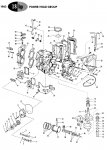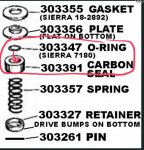Hi all, I just started getting into old outboards over the last few weeks. My first purchase was a Evinrude 1958 5.5 and now I'm hooked! I now have two 5.5s and two Johnson 18's a 1957 and a 1965. It's hard to believe the parts support for motors this old!!! I just started working on the 1957 and now that I have the flywheel off I started thinking about seal condition of these old motors. The upper crankshaft seal seems O.K. (no oil leakage) but will probably change it for safe measure as it's awesome that I won't have to split the case (no lip on seal) to do it. Is the lower seal (bottom of powerhead) the same, and anyone have experience replacing theirs? My reason for wanting to change these is fear of a leak causing a lean condition at WOT that would cause motor damage. Should this be a concern, or should I just not think about it and go have fun! In other words, how many of you with these old (beautiful) motors are running original seals? Thanks.
Last edited:






















